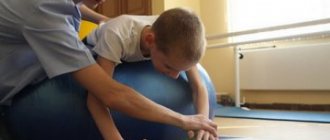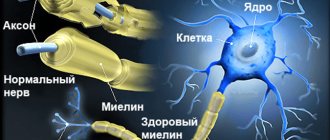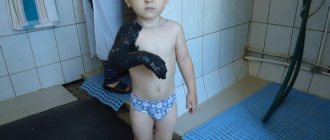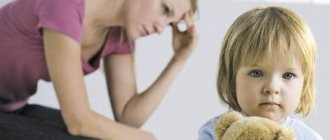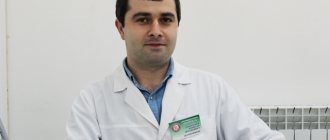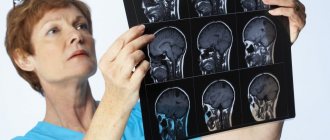Signs of cerebral palsy in children
The child learns to hold his head up, sit independently and walk later than necessary. Reflexes that should disappear by 6-8 months persist longer. Sometimes by the age of 1.5 years one arm works better because the other half of the body is weaker. Muscles can be both relaxed and overly tense, which is why the limbs have an unnatural state. Movements are too sudden or slow, often uncontrollable.
The following signs of the development of cerebral palsy in a child are also identified:
- skeletal deformity;
- asymmetry of the limbs;
- mental retardation - 30-50%;
- hearing impairment;
- speech problems;
- impaired swallowing;
- uncontrollable drooling;
- seizures - in 30% of cases;
- myopia or strabismus - 70%;
- uncontrolled urination and bowel movements.
Description of the disease
Paresis is a medical term for muscle weakness due to the fact that nerve impulses do not reach them.
The state of paresis differs from paralysis in that the body does not completely lose muscle functionality. In this article we will talk about hemiparesis on the left side of the body.
The disease most often occurs either in older people as a result of serious illnesses, or in young children as a result of perinatal pathologies (cerebral palsy).
Hemiparesis is a consequence of damage to neurons in the brain or spinal cord.
Left-sided hemiparesis may vary:
- By localization:
- Central;
- Peripheral.
- According to the speed of flow:
- Spicy;
- Slowly developing.
- By severity:
- Easy;
- Moderate;
- Deep.
Help: Symptoms of left-sided hemiparesis may differ, it all depends on the degree of damage to the central nervous system, the cause of the pathology, and the age of the patient. When the disease invades the brain and facial nerve, patients begin to experience problems with facial expressions.
In addition, you can identify the following symptoms:
- Increased muscle tone;
- Prolonged migraine;
- Fever;
- Lack of appetite and fatigue;
- Aching bones;
- Weight loss;
- Muscle resistance when trying to bend a limb;
- Muscles are affected unevenly;
- Strengthening tendon reflexes;
- Rossolimo reflex, Babinski reflex;
- Emotional swings, personality disorders.
Factors in the development of cerebral palsy
The causes of the disease include:
- premature or difficult labor
- hypoxia or asphyxia;
- infections during pregnancy;
- having a twin;
- congenital anomalies of the spinal cord or brain;
- impaired cerebral circulation;
- chronic diseases, hypo- and vitamin deficiency in the mother;
- smoking and drinking alcohol by the mother;
- Rhesus conflict.
There are often multiple risk factors present. It is not possible to name a specific reason in all cases.
Causes
There are many reasons for the development of cerebral palsy. The most common ones should be highlighted:
- Intrauterine brain damage
- Hypoxia during childbirth
- Intoxication
- Somatic and endocrinological diseases of the mother
- Rhesus conflict between mother and child
- Anomalies of labor (including birth injuries)
- Past infections
Under the influence of these and other reasons, direct damage to brain tissue occurs, and disturbances in its development processes begin to form. In this case, special attention should be paid to infectious diseases of the mother, which, today, account for more than half of all causes of cerebral palsy in a child.
Morphological changes in brain tissue are varied. Often, a child develops hemorrhages in the interthecal spaces and the brain tissue itself, degeneration of the structures of the cerebral cortex, and cicatricial changes occur. The lesion often affects (but is not limited to) predominantly the anterior parts of the brain.
Forms of the disease
Types of cerebral palsy in children are classified according to ICD-10. The syndrome belongs to class VI - diseases of the nervous system. Section - Cerebral palsy and other paralytic syndromes.
- Code G80.0 - spastic tetraplegia, prevalence - 2%
- G80.1 - spastic diplegia, 40%
- G80.2 - hemiplegic form, 32%
- G80.3 - dyskinetic, 10%
- G80.4 - ataxic, 15%
- G80.8 - mixed
- G80.9 - unspecified form.
Cerebral palsy: early diagnosis and rehabilitation treatment
Cerebral palsy (CP) is a disease that occurs as a result of brain damage in the perinatal period or as a result of an abnormality in its development and is characterized by disturbances in motor and statokinetic functions, as well as psycho-speech and sensory disorders, non-progressive, partly amenable to functional compensation and correction [1– 3].
The prevalence of cerebral palsy in Russia is 1.6–6 per 1000 full-term children, 9–40 per 1000 premature infants [3].
Unfavorable factors related to the origin of cerebral palsy: complicated somatic and gynecological history in the mother, pathology of pregnancy, perinatal lesions of the nervous system - hypoxic, infectious, toxic-metabolic, asphyxia during childbirth, birth trauma, brain dysgenesis [2–4].
Classifications of cerebral palsy
According to the International Statistical Classification ICD-10, the following are distinguished:
- G80.0 - Spastic cerebral palsy.
- G80.1 - Spastic diplegia.
- G80.2 - Childhood hemiplegia.
- G80.3 - Dyskinetic cerebral palsy.
- G80.4 - Ataxic cerebral palsy.
- G80.8 - Another type of cerebral palsy.
- G80.9 - Cerebral palsy, unspecified.
The clinical classification of Professor K. A. Semenova (1972) includes the following forms of cerebral palsy: double hemiplegia, spastic diplegia, hemiparetic form, hyperkinetic form, atonic-astatic form, mixed forms [2].
The European clinical classification of cerebral palsy (SCPE, 2000) identifies [3]:
- Spastic paralysis: unilateral (hemiplegia), bilateral (diplegia, quadriplegia).
- Dyskinetic: dystonic, choreoathetotic.
- Ataxic.
The frequency of forms of cerebral palsy: spastic diplegia - 69.3%, hemiparetic form - 16.3%, atonic-astatic form - 9.2%, hyperkinetic form - 3.3%, double hemiplegia - 1.9% [2].
Early manifestations of cerebral palsy are: delayed motor and psycho-speech development, absence or delayed reduction of innate and tonic reflexes, as well as delayed formation of attitudinal reflexes, impaired muscle tone, increased tendon reflexes, the appearance of pathological attitudes and synkinesis [5].
Early clinical and neurological diagnosis of cerebral palsy is largely based on the doctor’s knowledge of the sequence of formation of the stages of neuropsychic development of a child of the first year [1]: 1 month - the child tries to hold his head, fix his gaze, innate reflexes are expressed; 2 months - briefly holds the head on the stomach and in an upright position, fixes the gaze, hums, physiological astasia-abasia; 3 months - holds his head, follows the object, the grasping reflex weakens, and tries to voluntarily hold the inserted toy, rests on his forearms on his stomach; 4 months - turns his head in the direction of the sound, reaches out and takes a toy, turns on his side, sits down and sits with the support of his hands, pronounces vowel sounds; 5 and 6 months - sits with support from one hand or briefly independently, turns from back to side and stomach, distinguishes familiar faces, first syllables appear; 7 and 8 months - sits independently, gets on all fours, tries to stand briefly against a support; 9 and 10 months - kneels with support, stands and tries to move with support, stands independently for a short time, speaks the first words; 11 and 12 months - walks with one arm supported and tries to walk independently, follows simple instructions, speaks a few words, tries to feed himself with a spoon. Assessment of the degree of delay in motor and psycho-speech development: up to 3 months - mild, 3-6 months - moderate, more than 6 months - severe. Correction factors for prematurity: up to 1 year - the period of prematurity in months is added, from 1 year to 2 years - half the period of prematurity in months [5].
The motor development of a healthy child is characterized by a certain sequence, which is manifested by the extinction of unconditioned reflexes, the formation of righting (righting) reflexes, and the improvement of balance reactions [5, 6].
One of the early signs of cerebral palsy is a violation of the timely reduction (at 2 months in full-term infants, at 3–4 months in premature infants) of unconditioned reflexes - palmar-oral, proboscis, Moro, support reflex and automatic gait, postural reactions (labyrinthine, as well as cervical tonic - asymmetric and symmetrical - reflexes). As unconditioned reflexes fade, from the first month of life, adjustment reflexes are formed (labyrinth adjustment, chain cervical adjustment, etc.), which provide turns and straightening of the body, and are improved up to 10–15 months [1, 2, 6]. In patients with cerebral palsy, tonic reflexes can persist for life, which inhibits the formation of attitudinal reflexes, voluntary motor activity, and balance reactions and leads to the development of a pathological postural stereotype [5, 6].
Impaired muscle tone is one of the early signs of developing cerebral palsy [1, 2, 6]. Muscle hypertonicity and asymmetrical posture that persist after 4 months are observed in the consequences of perinatal lesions of the central nervous system (CNS), the threat of cerebral palsy (its spastic forms). The “spread out frog” position is observed with diffuse muscle hypotonia in premature infants, with hereditary diseases, perinatal lesions of the central nervous system, and the threat of atonic-astatic form of cerebral palsy [1, 2, 5].
Thus, early diagnosis of cerebral palsy can and should be carried out already in the first year of a child’s life, which can significantly reduce the risk of developing complications of cerebral palsy and the degree of disability of the patient.
Clinical forms of cerebral palsy
With spastic diplegia, a history of prematurity is common (67%), the clinical picture shows tetraparesis (the lower limbs are affected to a greater extent than the upper ones), sharply increased muscle tone of the limbs, body, tongue, high tendon reflexes, increased tonic reflexes, and pathological installation and deformation of the limbs, a spastic gait with a cross is formed, while only half of the patients walk independently, 30% with support, the rest move in a wheelchair. Speech disturbances in the form of spastic dysarthria and vision pathology in 70% of patients (refractive errors, optic nerve atrophy, strabismus) are characteristic [1, 2, 5]. The hemiparetic form is often caused by birth trauma; spastic hemiparesis is noted in the clinic, with the upper limb suffering more than the lower, shortening and hypotrophy of the affected limbs, hemiparetic gait, Wernicke-Mann posture with flexion of the arm and extension of the leg (“the hand asks, the leg squints”) is observed "), foot deformities and contractures on one side, the incidence of symptomatic epilepsy is high (about 35% of cases) [1, 2]. The hyperkinetic form is often the outcome of bilirubin encephalopathy, due to kernicterus, which develops in full-term newborns with a bilirubin level in the blood of 428-496 µmol/l, in premature infants - at 171-205 µmol/l. Characterized by violent involuntary movements (hyperkinesis) of the limbs and torso, which intensify with excitement and disappear during sleep. Hyperkinesis appears first in the tongue (at the age of 3–6 months), then spreads to the face, and then by 2–6 years to the trunk and limbs. There are disturbances in muscle tone such as dystonia, frequent autonomic disorders, hyperkinetic dysarthria, and sensorineural hearing loss (in 30–50%) [1, 2, 5]. The atonic-astatic form is characterized by low muscle tone, impaired coordination of movements and balance, as well as an excessive range of motion in the joints of the limbs. Double hemiplegia is the most severe form of cerebral palsy, manifested by gross motor impairment, increased muscle tone, tendon reflexes, severe speech impairment, and the mental development of children at the level of mental retardation [1, 2, 7].
The most significant complications of cerebral palsy: orthopedic and surgical disorders (hip dysplasia, foot deformities - equinus, valgus, varus, contractures of the joints of the extremities), speech and cognitive disorders in the form of delayed psycho-speech development or mental retardation (more than 60%), episyndrome ( in 35%), behavioral disorders, neurotic disorders (in 65% of patients), autonomic dysfunction syndrome (in more than 70%), asthenic syndrome (in more than 85%) [1, 2, 7, 8].
Rehabilitation of cerebral palsy
The leading principles of cerebral palsy rehabilitation are: early onset, comprehensive multidisciplinary approach, differentiated nature, continuity, duration, phasing, succession. Rehabilitation treatment of a patient with cerebral palsy should be carried out in accordance with an individual rehabilitation program and include the following areas [2, 4–8]:
- Medical rehabilitation: drug therapy, physical therapy and massage (classical, segmental, periosteal, connective tissue, circular trophic, acupressure), Vojta therapy, neurodevelopmental system B. and K. Bobath; the use of therapeutic and loading suits ("Adele", "Gravistat", "Regent", "Spiral"), pneumatic suits ("Atlant"), mechanotherapy (exercises using simulators and special devices, including robotic complexes (Lokomat, etc. ), physiotherapy (electrotherapy, electrophoresis and electromyostimulation, magnetic therapy, paraffin-socerite applications, mud therapy, hydrokinesitherapy, acupuncture), orthopedic-surgical and sanatorium-resort treatment [2, 6–8].
- Psychological, pedagogical and speech therapy correction (psychocorrection, sensory education, classes with a speech therapist-defectologist, conductive pedagogy by A. Peto, the Montessori method, work with families, etc.) [3, 7].
- Social and environmental adaptation.
Drug therapy for cerebral palsy includes [4, 5, 7]:
- drugs that have neurotrophic and nootropic effects (Cortexin, Cerebrolysin, Nootropil, Phenibut, Pantogam, Encephabol);
- drugs that improve general cerebral hemodynamics and microcirculation (Cortexin, Cinnarizine, Actovegin, Trental, Instenon, etc.);
- drugs that improve metabolism in the nervous system, reparative and absorbable effects (ATP, Elcar, Lidaza, Vitreous, Derinat);
- anticonvulsants for the combination of cerebral palsy with convulsive syndrome (valproates - Konvulex, Depakin, etc.);
- drugs that normalize muscle tone (for hypertonicity - Mydocalm, Baclofen, botulinum toxin preparations; for hypotension - Proserin, Galantamine);
- drugs that reduce hyperkinesis (Pantogam, Phenibut, Nacom, Tiapridal);
- vitamins (B1, B6, B12, C, Neuromultivit, Milgamma, Aevit, etc.).
One of the complex drugs that has found active use in neurorehabilitation is Cortexin (INN - polypeptides of the cerebral cortex of livestock) [7–9]. Cortexin belongs to pharmacological group 9.7 (“Nootropics (neurometabolic stimulants)”). According to the ATC system (anatomical-therapeutic-chemical) classification, the drug belongs to heading N06 BX (“Other psychostimulants and nootropic drugs”). Cortexin is an innovative drug, its substance and dosage forms are protected by patents of the Russian Federation (RF No. 2104702b 2275924b 2195297) and other countries [7–9]. Cortexin contains not only neuropeptide substances, but also 20 amino acids, a number of vitamins and minerals, which explains its high neurochemical activity in regulating the processes of neurocellular dynamics and apoptosis, providing mechanisms of neuroprotection. Cortexin is available as a lyophilisate in bottles of 10 mg and 5 mg (Cortexin for children). Before injection, the contents of the bottle are dissolved in 1.0–2.0 ml of a 0.5% solution of novocaine, water for injection or isotonic sodium chloride solution. The drug is prescribed intramuscularly, for children weighing up to 20 kg - at a dose of 0.5 mg/kg, and for children weighing more than 20 kg - at a dose of 10 mg. The duration of the course is 10–20 days.
The results of numerous studies indicate the high effectiveness of Cortexin in the complex rehabilitation of children with diseases of the nervous system, including perinatal lesions of the nervous system and cerebral palsy, which is due to its direct effect on the metabolism of nerve cells, normalization of cerebral and systemic circulation, and a decrease in the manifestations of convulsive syndrome [7 -10]. Cortexin is included in clinical recommendations [4] and standards of medical care for cerebral palsy (Order of the Ministry of Health of the Russian Federation dated June 16, 2015 No. 349n “On approval of the standard of specialized medical care for cerebral palsy”).
Significant positive experience has been accumulated in the use of Cortexin in the acute period of perinatal cerebral pathology, and it has been revealed that its use in the complex treatment of critical conditions in children reduces the duration of intensive care and the length of stay of patients in the intensive care unit, the average length of hospital treatment and the stage of primary neurological rehabilitation, which significantly improves the prognosis for the recovery of motor and cognitive functions, as well as the neurological status of the patient as a whole [9–11]. Analysis of the results of the use of Cortexin in the rehabilitation of children in the first years of life with consequences of perinatal central nervous system damage indicates a significant improvement in motor and cognitive functions, as well as pre-speech and speech development [11–13].
When studying the effectiveness of rehabilitation treatment using Cortexin in 67 children aged 3 months to 3 years with developmental disorders of psychoneurological functions of perinatal origin, a significantly more intensive formation of the functions of visual and auditory perception, impressive speech, and communicative functions was noted than in treatment without Cortexin [11 ].
Clinical and psychological examination of 96 patients aged 1–15 years with cerebral pathology of various origins (including perinatal damage to the central nervous system), when Cortexin was used in complex treatment, revealed in 70.2% of patients a good clinical effect in the form of improved well-being, increased academic performance at school, improvements in integrative brain functions, a satisfactory result was achieved in 22.4%, and in the control group, satisfactory and “no changes” results were noted 2 times more often [12]. There was a significant improvement in the function of attention according to the correction test, and positive changes in electroencephalography (in patients receiving Cortexin, indicators improved in 76% of cases, and in the control group - only in 50%) [12]. The researchers also revealed a clear decrease in the content of CPK-BB, the degree of accumulation of which serves as an indicator of the pathological state of the central nervous system, under the influence of treatment with Cortexin, in 62.2% of those examined, which was significantly lower than with traditional treatment, and allowed us to make an assumption about the neuroprotective effect of the drug , which promotes metabolic support of the affected neuron and restoration of impaired brain functions [12].
When examining 135 children (aged from 1 month to 5 years) with consequences of perinatal damage to the central nervous system, pronounced positive neurophysiological dynamics were observed during the use of Cortexin, while as a result of 5 years of treatment with its use, complete compensation of motor and cognitive disorders was observed in 74% , and without it - in only 9.6% of patients [13].
Conducting a comparative study of the effect of Cortexin in combination with kinesiotherapy on impaired motor and cognitive functions in 118 patients with cerebral palsy aged 1 to 18 years (in this case, 73 patients in the main group underwent rehabilitation using kinesitherapy in combination with treatment with Cortexin, 45 patients in the control group - kinesiotherapy only) revealed a significant positive effect of Cortexin at the end of a two-month course of treatment, manifested both in improvement of motor abilities and indicators of cognitive activity (auditory-verbal memory, attention, object-related activity) [14].
During the observation of 25 children with cerebral palsy aged 6–15 years, it was shown that the use of Cortexin (5 courses of 10 injections at intervals of 3 months) significantly increased the volume of motor activity, the range of motor skills, improved hand-eye coordination, and normalized the sleep-wake cycle, the emotional background improved, and disorders of the articulatory apparatus decreased. The cumulative effect of the drug was revealed: with repeated courses of therapy, its positive effect persisted for 6 to 18 months [15].
When examining 22 patients with cerebral palsy aged 11–18 years in the process of complex rehabilitation with 20-day use of Cortexin (course dose 200 mg), a significant improvement in well-being, behavior, communication and integrative functions was noted in 62.1% of patients, a moderate improvement in the form reduction in the severity of subjective manifestations - in 33.3% of those examined [16].
A high result has been shown in the treatment of speech disorders in cerebral palsy with Cortexin in combination with reflexology [17]. 78 children with cerebral palsy aged 2 to 7 years with atonic-astatic and spastic forms of the disease received treatment on an outpatient basis. For treatment, courses of microcurrent reflexology (MCRT) were used according to the author’s method in combination with a course of Cortexin. Analysis of the results of complex treatment with a combination of MPRT and Cortexin showed its high effectiveness in restoring speech functions in children with cerebral palsy in relation to patients in the comparison group [17].
One of the pressing problems in the treatment of cerebral palsy, especially the hemiparetic form, is the presence of concomitant epilepsy, which often occurs against the background of impaired cognitive functions, when, along with basic anticonvulsant therapy, there is a need to prescribe a drug that has a cerebroprotective and neurotropic effect, and also does not cause an increase in seizure activity [ 18–20]. A study of the effectiveness of using Cortexin in children with epilepsy showed that after a course of treatment with the drug, not a single patient had a recurrence of epileptic seizures, 40–50% of children had improved memory and attention, and positive dynamics of psychomotor and speech development were noted [18].
When studying the effectiveness of Cortexin in children suffering from generalized epilepsy (21 children aged 10–11 years were examined), it was found that not a single patient had a relapse of epileptic seizures, while improved memory and positive dynamics in psycho-speech development were noted in 70% of patients [19]. Special conditions for prescribing Cortexin as a nootropic therapy in patients with epilepsy have been noted: stable remission, as well as in patients with persistent attacks, but in the period after the second month since the last change of antiepileptic therapy [20].
Thus, the complex effect and wide range of clinical use of Cortexin for perinatal lesions of the nervous system and cerebral palsy is due to a combination of nootropic, neurotrophic, neuroprotective, reparative and anticonvulsant effects, as well as its antioxidant, metabolic and anti-stress effects. The presented results confirm the high therapeutic effectiveness of the drug Cortexin in complex rehabilitation for various diseases of the central nervous system in children.
Early diagnosis and comprehensive rehabilitation treatment help to increase the effectiveness of rehabilitation measures, reduce disability and increase social adaptation of children with cerebral palsy.
Literature
- Badalyan L. O., Zhurba L. T., Timonina O. V. Cerebral palsy. Kyiv, Health, 1988. 327 p.
- Semenova K. A. Restorative treatment of children with perinatal damage to the nervous system and cerebral palsy. M.: Codex, 2007.
- Diseases of the nervous system in children. Ed. J. Aicardi. M., Binom, 2013. T. 1, p. 221–259.
- Child neurology. Clinical recommendations. Ed. Guzevoy V.I.M., 2014.
- Nemkova S. A., Zavadenko N. N., Medvedev M. I. Modern principles of early diagnosis and complex treatment of perinatal lesions of the central nervous system and cerebral palsy. Toolkit. M., 2013. 76 p.
- Kozhevnikova V. T. Modern technologies for physical rehabilitation of patients with consequences of perinatal damage to the nervous system and cerebral palsy. M., 2013. 567 p.
- Nemkova S. A. Cerebral palsy: Modern technologies in complex diagnosis and rehabilitation of cognitive disorders. M.: Medpraktika-M, 2013. 442 p.
- Cerebral palsy: effective ways to combat movement disorders / Ed. Umnova V.V. St. Petersburg, 2013. 235 p.
- Nemkova S. A., Maslova O. I., Karkashadze G. A., Kurbatov Yu. N., Podkorytova I. V. Use of a polypeptide stimulant in the complex treatment of cognitive impairment in children with diseases of the central nervous system // Pediatric pharmacology, 2012 No. 5.
- Nemkova S. A., Zavadenko N. N., Suvorinova N. Yu. Use of cortexin in complex neurorehabilitation in children // Russian Bulletin of Perinatology and Pediatrics, 2015, 2: 37–44.
- Kleimenova I. S. Effective treatment of developmental disorders of psycho-neurological functions in young children. In the book: Neuroprotection in acute and chronic cerebral circulatory failure. St. Petersburg: Nauka, 2007. pp. 159–165.
- Platonova T.N. Use of cortexin in the complex treatment of diseases of the nervous system in children // Terra medica. 2000; 4:50–53.
- Gromada N. E. Towards the treatment of long-term consequences of perinatal CNS damage. In the book: Neuroprotection in acute and chronic cerebral circulatory failure. St. Petersburg: Nauka, 2007. pp. 149–151.
- Isanova V. A., Ismagilov M. F. Cortexin in complex rehabilitation of patients with cerebral palsy // Neurological Bulletin. 2008; 15 (4): 125–127.
- Studenikin V.M., Pak L.A., Shelkovsky V.I. et al. The use of cortexin in pediatric neurology: experience and prospects // Pharmateka. 2008; 14:23–29.
- Ivannikova N.V., Esaulova I.V., Avdonina V.Yu. et al. Cortexin in complex habilitation and rehabilitation of children with disabilities // Terra Medica. Special issue. 2004: 7–8.
- Ukhanova T. A., Gorbunov F. E., Ivanova V. V. Treatment of speech disorders in cerebral palsy by combining reflexology with cortexin // Journal of Neurology and Psychiatry named after. S. S. Korsakova. 2011; 8:19–22.
- Guzeva V.I., Trubacheva A.N. Use of cortexin in the complex treatment of epilepsy in children // Terra Medica. 2003; 2:19–21.
- Fedunova G.V., Sysoeva E.N. Experience of using cortexin for symptomatic epilepsy in children // Chief Physician. 2008; 4 (16): 32.
- Koroleva N. Yu., Voronkova K. V., Tarabrin P. P. Impaired cognitive functions in patients with epilepsy, the influence of antiepileptic therapy and correction of disorders // Review of Psychiatry and Medical Psychology named after. V. M. Bekhtereva. 2010; 4:41–46.
S. A. Nemkova, Doctor of Medical Sciences, Professor
GBOU VPO RNIMU im. N. I. Pirogova Ministry of Health of the Russian Federation, Moscow
Contact Information
Child development with cerebral palsy
Psycho-emotional characteristics manifest themselves in different ways: some children are irritable, excitable, and suffer from sudden changes in mood. Others are shy, fearful, and have difficulty communicating with people.
Restriction of physical activity causes curvature of the spine, contracture and internal pathologies. Due to speech impairments, meaningful communication is limited or absent. Parents should not show excessive pity and impressionability in their upbringing. It is necessary to praise the child more often, encourage him to take active actions, and form normal self-esteem; all this is very important for the normal development of the child. Parents should help the patient adapt socially.
Left-sided spastic hemiparesis
Spastic hemiparesis occurs when the head or cervical region is affected, and causes stiffness of the muscles on the opposite side of the body, in this case, the left.
Spastic hemiparesis manifests itself gradually. First, spasticity appears - tension in the limbs , which is felt as a kind of stiffness. Without treatment, this condition eventually develops into full-fledged hemiparesis.
People with spastic hemiparesis typically have characteristic external symptoms that are noticeable to others, such as the Wernicke-Mann gait.
Diagnostics
You should contact a neurologist if you suspect the development of cerebral palsy in a child if:
- at 1 month he does not blink his eyes at loud noises;
- at 4 months does not reach for toys and does not turn towards sounds;
- at 7 months does not sit independently;
- at 1 year of age does not speak words and acts with one hand;
- does not walk or moves incorrectly;
- experiences convulsions;
- makes sudden or excessively smooth movements.
To make a diagnosis, a neurologist studies the medical history, pregnancy and childbirth, and conducts an examination. Blood tests, urine tests, and MRI are prescribed. As well as a number of studies to exclude genetic diseases.
Treatment
Therapy for cerebral palsy is a multifaceted task. It must be comprehensive and include medications, physiotherapy, psychotherapy, speech correction, massage, the use of special orthopedic devices, and physical therapy.
— Among drug therapy, the most important is given to neuroprotective drugs (Cortexin, Actovegin, Cerepro), as well as muscle relaxants (baclofen, mydocalm) to relieve spasticity. Vitamin and other metabolic drugs are widely used. If necessary, sedatives are used. The presence of symptomatic epilepsy presupposes the use of antiepileptic drugs.
— Physiotherapy, physical therapy, massage are aimed at reducing the lag in motor development. Also, activation of motor function helps to improve the mental development and social adaptation of a patient with cerebral palsy.
Recently, methods of treating cerebral palsy such as hippotherapy (treatment with contact with horses) have become fashionable. However, these techniques are not always available and, as a rule, expensive, so they are not widely used.
CLASSIFICATION
Currently, at the Vremena Goda clinic, we adhere to the classification and terminology according to ICD-10:
Class VI DISEASES OF THE NERVOUS SYSTEM
Cerebral palsy and other paralytic syndromes (G80 - G83)
- G 80. Cerebral palsy
- G 80.0. Spastic cerebral palsy
- G 80.1. Spastic diplegia
- G 80.2. Childhood hemiplegia
- G80.3. Dyskinetic cerebral palsy. Athetoid cerebral palsy
- G80.4. Atactic cerebral palsy
- G80.8. Another type of cerebral palsy Mixed cerebral palsy syndromes
- G80.9. Cerebral palsy, unspecified
- G 81. Hemiplegia
- G 81.0. Flaccid hemiplegia
- G 81.1. Spastic hemiplegia
- G81.9. Hemiplegia, unspecified
- G 82.0 Flaccid paraplegia
- G 82.1 Spastic paraplegia
- G 82.2 Paraplegia, unspecified
- G 82.3 Flaccid tetraplegia
- G 82.4 Spastic tetraplegia
- G 82.5 Tetraplegia, unspecified. Quadriplegia
- G 83.0 Diplegia of the upper limbs
- G 83.1 Monoplegia of the lower limb. Paraplegia
- G 83.2 Monoplegia of the upper limb. Upper limb paralysis
- G 83.3 Monoplegia, unspecified
- G 83.4 Cauda equina syndrome. Neurogenic bladder associated with cauda equina syndrome
- G 83.8 Other specified paralytic syndromes. Todd's palsy (post-epileptic)
- G 83.9 Paralytic syndrome, unspecified
The most common forms of cerebral palsy are:
Spastic diplegia
(“Tetraparesis with spasticity in the legs”, by Michaelis)
The most common type of cerebral palsy (3/4 of all spastic forms), previously also known as “Little’s disease.” The function of the muscles on both sides is impaired, more so in the legs than in the arms and face. Spastic diplegia is characterized by the early formation of pronounced deformities of the spine and joints, up to the development of contactures. It is mainly diagnosed in children born prematurely (consequences of intraventricular hemorrhages, periventricular leukomalacia, and other factors).
In contrast to spastic quadriplegia, the posterior and, less commonly, middle parts of the white matter are more affected. With this form, as a rule, tetraplegia (paresis) is observed, with pronounced spasticity mainly in the legs. The most common manifestations are delayed mental and speech development, the presence of pseudobulbar syndrome, and dysarthria. Pathology of the cranial nerves is common: convergent strabismus, complex visual acuity disorders, hearing impairment, speech impairment in the form of delayed speech development, moderate decline in intelligence, including those caused by the influence of the environment on the child (insults, segregation). The prognosis for motor abilities is less favorable than for hemiparesis. This form is the most favorable with regard to the possibilities of social adaptation. The degree of social adaptation can reach the level of healthy people with normal mental development and good hand function.
Spastic tetraplegia
With greater severity of movement disorders in the hands, the clarifying term “bilateral hemiplegia” can be used.
One of the most severe forms of cerebral palsy, which is a consequence of abnormalities in brain development, intrauterine infections and perinatal hypoxia with diffuse damage to the cerebral hemispheres. In premature infants, the main cause of perinatal hypoxia is selective neuronal necrosis.
Spastic tetraplegia (paresis) is clinically diagnosed; pseudobulbar syndrome, visual impairment, cognitive and speech impairment. 50% of children experience epileptic seizures. This form is characterized by the early formation of contractures, deformations of the trunk and limbs. In almost half of the cases, movement disorders are accompanied by pathology of the cranial nerves: strabismus, atrophy of the optic nerves, hearing impairment, and pseudobulbar disorders. Severe motor defects of the hands sharply limit the possibilities of self-care and movement, but in some cases, with long-term specialized treatment, good results can be achieved.
Hemiplegic form
Characterized by unilateral spastic hemiparesis. The arm usually suffers more than the leg. The cause in premature infants is periventricular (periventricular) hemorrhagic infarction (usually unilateral), and congenital cerebral anomaly. Ischemic stroke (cerebral infarction) or intracerebral hemorrhage usually occurs in one of the hemispheres (usually in the left middle cerebral artery) in full-term infants. The level of social adaptation, as a rule, is determined not by the degree of motor defect, but by the intellectual capabilities of the child.
Clinically characterized by the development of spastic hemiparesis (Wernicke-Mann type gait), delayed mental and speech development.
Dyskinetic form
(The term “hyperkinetic form” is sometimes used)
One of the most common causes of this form is previous hemolytic disease of newborns, which was accompanied by the development of “nuclear” jaundice. Also the cause is status marmoratus of the basal ganglia in full-term children. With this form, as a rule, the structures of the extrapyramidal system and the auditory analyzer are damaged. The clinical picture is characterized by the presence of hyperkinesis: athetosis, choreoathetosis, dysarthria, oculomotor disorders, hearing loss. Hyperkinesis is usually accompanied by an increase in muscle tone, which may simultaneously lead to paralysis (paresis). Speech disorders are observed more often in the form of hyperkinetic dysarthria.
Intelligence develops generally satisfactorily. There is no correct alignment of the torso and limbs. Most children show preservation of intellectual functions, which has a favorable prognosis for social adaptation and learning. Children with good intelligence graduate from school, secondary specialized and higher educational institutions, and adapt to certain work activities. There are athetoid and dystonic (with the development of chorea and torsion spasms) variants of this form of cerebral palsy.
Ataxic form
It is characterized by low muscle tone, ataxia and high tendon and periosteal reflexes. Speech disorders in the form of cerebellar or pseudobulbar dysarthria are common. It is observed with predominant damage to the cerebellum, fronto-pontine-cerebellar tract and, probably, the frontal lobes due to birth trauma, hypoxic-ischemic factor or congenital malformation.
Clinically characterized by a classic symptom complex (muscle hypotonia, ataxia) and various symptoms of cerebellar asynergia (dysmetria, intention tremor, dysarthria). With this form of cerebral palsy, a moderate delay in the development of intelligence is emphasized, and in some cases mental retardation occurs in the degree of deep debility or imbecility. More than half of the cases diagnosed with this form are unrecognized early hereditary ataxias.
Mixed forms
Despite the possibility of diffuse damage to all motor systems of the brain (pyramidal, extrapyramidal and cerebellar), the above-mentioned clinical symptom complexes make it possible in the vast majority of cases to diagnose a specific form of cerebral palsy. However, in a number of cases, a combination of spastic and dyskinetic (with combined severe damage to the extrapyramidal system) forms, the presence of hemiplegia against the background of spastic diplegia and other individual characteristics are noted that make it difficult to determine the form of cerebral palsy.
Prognosis for adults and children
The prognosis for left-sided hemiparesis depends on many factors: the patient’s age, his medical history, how quickly treatment and recovery began. But, most often, with acquired hemiparesis, the prognosis is favorable, and most patients can restore all muscle functions .
Information: In cases of congenital hemiparesis in a child, doctors usually give cautious prognoses. Because mild forms of left-sided hemiparesis respond well to treatment, while severe forms can only be partially corrected.
